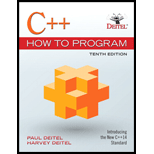
Concept explainers
(Removing Duplicated Code in the main Function) In Fig. 3.9, the main function contains six statements (lines 14-15, 16-17, 26-27, 28-29, 37-38 and 39-40) that each display an Account object's name and balance. Study these statements and you'll notice that they differ only in the Account object being manipulated-accountl or account2. In this exercise, you'll define a new displayAccount function that contains one copy of that output statement. The member function's parameter will be an Account Object and the member function will output the object's name and balance. You'll then replace the six duplicated statements in main with calls to displayAccount, passing as an argument the specific Account object to output.
-
Modify Fig. 3.9 to define the following displayAccount function after the using directive and before main:
void displayAccount(Account accountToDisplay) {
// place the statement that displays
// accountToDisplay's name and balance here
}
Replace the comment in the member function's body with a statement that displays accountToDisplay’s name and balance.
Once you've completed displayAccount’s declaration, modify main to replace the statements that display each Account’s name and balance with calls to displayAccount of the form:
displayAccount(nameOfAccountObject);
In each call, the argument should be the account1 or account2 object, as appropriate. Then, test the updated
Want to see the full answer?
Check out a sample textbook solution
Chapter 3 Solutions
C++ How To Program Plus Mylab Programming With Pearson Etext -- Access Card Package (10th Edition)
Additional Engineering Textbook Solutions
Introduction To Programming Using Visual Basic (11th Edition)
Database Concepts (8th Edition)
SURVEY OF OPERATING SYSTEMS
BASIC BIOMECHANICS
Fluid Mechanics: Fundamentals and Applications
Java: An Introduction to Problem Solving and Programming (8th Edition)
- Describe three (3) Multiplexing techniques common for fiber optic linksarrow_forwardCould you help me to know features of the following concepts: - commercial CA - memory integrity - WMI filterarrow_forwardBriefly describe the issues involved in using ATM technology in Local Area Networksarrow_forward
- For this question you will perform two levels of quicksort on an array containing these numbers: 59 41 61 73 43 57 50 13 96 88 42 77 27 95 32 89 In the first blank, enter the array contents after the top level partition. In the second blank, enter the array contents after one more partition of the left-hand subarray resulting from the first partition. In the third blank, enter the array contents after one more partition of the right-hand subarray resulting from the first partition. Print the numbers with a single space between them. Use the algorithm we covered in class, in which the first element of the subarray is the partition value. Question 1 options: Blank # 1 Blank # 2 Blank # 3arrow_forward1. Transform the E-R diagram into a set of relations. Country_of Agent ID Agent H Holds Is_Reponsible_for Consignment Number $ Value May Contain Consignment Transports Container Destination Ф R Goes Off Container Number Size Vessel Voyage Registry Vessel ID Voyage_ID Tonnagearrow_forwardI want to solve 13.2 using matlab please helparrow_forward
- a) Show a possible trace of the OSPF algorithm for computing the routing table in Router 2 forthis network.b) Show the messages used by RIP to compute routing tables.arrow_forwardusing r language to answer question 4 Question 4: Obtain a 95% standard normal bootstrap confidence interval, a 95% basic bootstrap confidence interval, and a percentile confidence interval for the ρb12 in Question 3.arrow_forwardusing r language to answer question 4. Question 4: Obtain a 95% standard normal bootstrap confidence interval, a 95% basic bootstrap confidence interval, and a percentile confidence interval for the ρb12 in Question 3.arrow_forward
 C++ Programming: From Problem Analysis to Program...Computer ScienceISBN:9781337102087Author:D. S. MalikPublisher:Cengage Learning
C++ Programming: From Problem Analysis to Program...Computer ScienceISBN:9781337102087Author:D. S. MalikPublisher:Cengage Learning C++ for Engineers and ScientistsComputer ScienceISBN:9781133187844Author:Bronson, Gary J.Publisher:Course Technology Ptr
C++ for Engineers and ScientistsComputer ScienceISBN:9781133187844Author:Bronson, Gary J.Publisher:Course Technology Ptr Microsoft Visual C#Computer ScienceISBN:9781337102100Author:Joyce, Farrell.Publisher:Cengage Learning,
Microsoft Visual C#Computer ScienceISBN:9781337102100Author:Joyce, Farrell.Publisher:Cengage Learning,- COMPREHENSIVE MICROSOFT OFFICE 365 EXCEComputer ScienceISBN:9780357392676Author:FREUND, StevenPublisher:CENGAGE LProgramming Logic & Design ComprehensiveComputer ScienceISBN:9781337669405Author:FARRELLPublisher:Cengage




